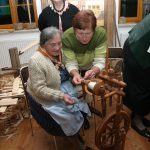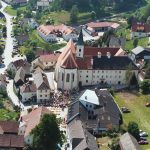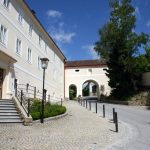Schönbach, Lower Austria, Austria
Schönbach, a rural municipality with approx. 930 inhabitants at the centre of Waldviertel, is characterised by a charming landscape and difficult conditions for farming – high percentage of forest, small sectioned ownership structure and slope location. The village is of historical interest as a pilgrimage village with its church that was built in 1450 and as a transit station for a Rome pilgrimage between Prague and Maria Zell; due to the restrictive religious politics of Emperor Joseph II. this pilgrimage came to a standstill. Also the earlier frequent visits of holidaymakers from the state capital Vienna has drastically dropped.
The general efforts of the municipality and the very committed citizens are – based on a Leader strategy concept – directed towards strengthening the economy by activities in the farming, trade and cultural areas. It is especially noteworthy that in as much as Schönbach despite its decentralised location remote from regional arterial roads has built up a respectable economic basis in the last few years: Along with 120 farms, of which approx. 50 are operated full-time, there are almost 50 companies in secondary and tertiary areas of which alone 17 companies with approx. 40 employees were founded in the last 15 years. Amongst them are new start-ups by municipal citizens that had already left home but have returned again. The is impressive proof of how closely the citizens of Schönbach are affiliated to their home that forms the basis for the generally observed the great commitment of the citizens to redesign their living area.
For a rural community the provision of infrastructures for sports and leisure is above average (children’s playground, large sport area, sports hall, swimming pool) also in the administrative sector (new municipal centre in the municipal building yard) and in gastronomy. Along with three inns there is a small private brewery in the former monastery which serves beer in a grand arched room and represents a particular attraction for tourists.
The heating for the primary school, the municipal centre and the swimming pool is provided by a heating plant that is operated with wood chips and sun flowers seeds from the municipality. The separate subsidy from the municipality for solar panels is further proof that the use of renewable energy is of great importance.
The open-mindedness of the village population towards innovations and contemporary requirements is shown in a plenitude of activities in social, cultural and economic areas. Exemplary are initiatives for blanket broadband provision, the holding of European farmer markets, the installation of a farmer timber exchange, the general training of all school children in first aid, the use of acoustic methods for brain friendly learning in primary school, the impending conversion of a monastery courtyard to a theatre stage, the exhibition of the treasures of the former monastery in the rectory and the erection and operation of an adventure workshop in the new municipal centre including selling facilities in the monastery to revitalise and utilise handcraft products on an economically sustainable basis. In the meantime in the adventure workshop, courses especially for young people and also interregional, are being held in traditional handcraft techniques (basket weaving, making wooden tiles, production of soap from rapeseed oil reserves) The renovated monastery including surroundings is proof of the willingness of the inhabitants to preserve the culturally historic heritage.
A long term project that ties into the traditionally important role of Schönbach as a pilgrimage town is the Via lucis, a way of the cross endowed by a son of the municipality that in 14 stations demonstrates the positive in Christian religion. The decoration of this way of the cross will be done by works of freelance artists (each year one object) in the next few years.
The municipality of Schönbach is characterised by an exceptionally high level of citizen commitment and the willingness to implement innovative ideas, especially to revitalise the economy and the culture. Outstanding are also the revitalisation of the monastery complex, the willingness to use alternative energy and the successful efforts to create a contemporary infrastructure.
Evaluated: 2008




